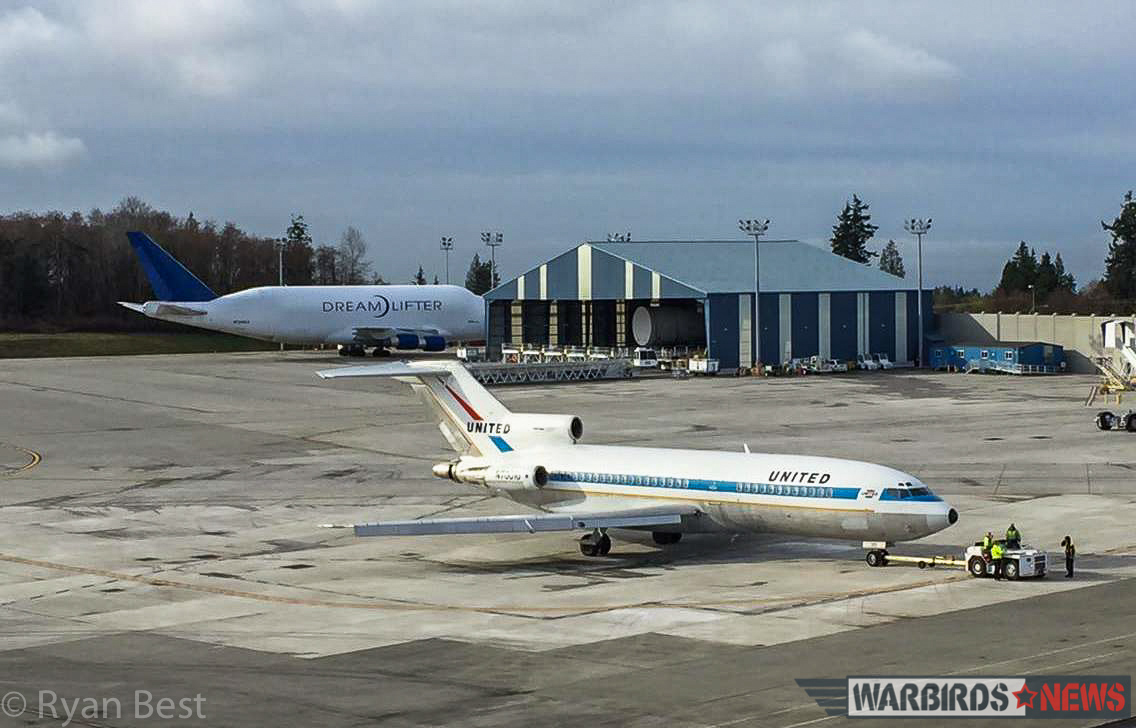
The evocative and now sadly rare whine of three Pratt&Whitney JT8D engines ringing in close harmony echoed over Paine Field in Everett, Washington as the prototype Boeing 727 airliner made her final flight today; a short hop from the Museum of Flight’s restoration facility to the main museum site at Boeing Field in nearby Seattle. As most of our readers will know by now, the aircraft has been under preparation for this journey for some years now, with the museum deeming it more practical, and less expensive to fly the aircraft to her final home, than dismantle and move her by road.
While the restoration has likely taken several million dollars to accomplish, the bulk of this has come from volunteer labor as well as in-kind donations from the likes of Boeing, United Airlines and Federal Express, meaning that actual financial outlay from the museum has been relatively low for such a massive endeavor.
It’s hard to imagine a more romantic way of sending the 727 to her new home either, and thousands of people were on hand to witness the take off and landing of this historic airliner, one of the most important transport types of all time. Amazingly, it wasn’t until the 1970s that the venerable DC-3 was exceeded in numbers on the civil registry around the world, and it was the 727 that accomplished this. The 727 had a long production run following her first flight on February 9th, 1963. The assembly line didn’t close until 1984. Very few operators still fly the 727, due to the much improved efficiency and quietness of more modern aircraft. The remaining examples operate mostly in air-cargo roles. FedEx was one of the last users of the type, and greatly assisted the Museum of Flight’s restoration, by donating parts and systems, not to mention more than half a dozen engines to rebuild three operable units for the final flight.
Saving the 727 prototype was more or less a lucky accident. Retired Boeing engineer, and long-time Museum of Flight employee, Bob Bogash happened to see the aircraft from his seat upon landing at O’Hare International in 1984. The 727 prototype served its entire commercial life with United Airlines, who agreed to donate the airframe to the Museum of Flight when it’s flying days were over, so in 1991 they ferried her to Paine Field. Because the museum hadn’t got a hangar big enough to house the 727 indoors, she has sat outside since that time, which has presented considerable obstacles to her maintenance and preservation.
The Museum of Flight press release noted the following… “The 727’s brief trip from Everett to Seattle was flown under a special flight permit, with only essential flight crew onboard during the flight: pilot Tim Powell, co-pilot Mike Scott, flight engineer Ralph Pascale, and safety officer Bob Bogash. Powell, Scott and Pascale fly 727s on a regular basis; airline and corporate pilot Powell has over 10,000 hours at the controls of various 727s. Bogash is the Museum’s 727 project manager.”
Now that the airliner is at Boeing field, she will remain on outdoor display for a few more months in the Air Park beside the main museum building until the new Aviation Pavilion is ready to take her in late summer. The 727 will then take pride of place alongside a number of other Boeing airliner prototypes, including the 737 and 747 Jumbo Jet! Bravo to all concerned at the Museum of Flight for ensuring that this jewel of an aircraft has been saved for future generations to come!
WarbirdsNews wishes to express much gratitude to Joe Kunzler, Dan Hagedorn, Michael Grant, who helped with this article, and of course to the many people at the Museum of Flight who helped make this monumental flight possible!



































